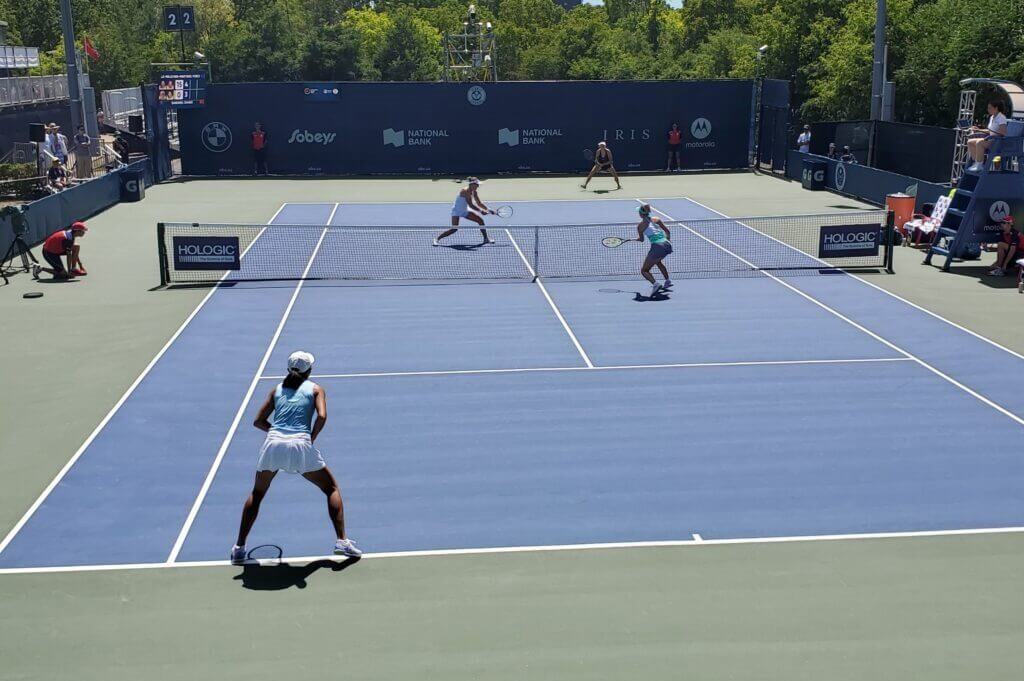Poaching is one of the more aggressive tactics in tennis doubles. It often makes your opponents so uncomfortable that it takes them out of their game. But the big question many recreational players always ask is, “When do I poach”?
Obviously, you can (and should) poach at any time, and the more you put yourself in front of the ball (at the net), the more your intuition and instincts will develop.
Unfortunately, many players are afraid to give poaching a try. They worry that if they go for the poach, the opponent will rip it down their line. Another concern is that they’ll misjudge the ball and flub the poach, and their partner will get mad.
Sooooooooo… How exactly do you become a good poacher? It’s not as hard as you think. Most of the time, you’ll recognize an easy opportunity and take it. Other times, you’ll be able to plan for it, like when it’s your partner’s serve. Tell them to serve down the T and that you’ll poach on the return. This lets your partner know to keep an eye on you and to switch sides when you poach. It also helps prepare you mentally to do it.
When Should I poach?
Other than the “gift,” where an opponent accidentally hits a floater almost right to you, the following are some of the most optimal times to poach. Print this post, keep it in your bag, and look at it before your matches. And as soon as you recognize the scenario unfolding on the court – poach!
- POACH early in the match – in the first game or in the first point. Even if it’s a bust, they will now be worried about your aggressive badassery and not their game during every point for the rest of the match.
- POACH when they hit an approach shot because 99% of the time, it will be going cross-court. And if they happen to go down your line, your partner should be switching sides anyway, so she can get it.
- POACH when they slice. You will have more time to get to the ball, as this shot is typically slower and sits up higher.
- POACH when your partner hits the ball deep and to their feet. Often this offensive shot will come back slow and high for a nice volley put away.
- POACH on their weapon. Suppose their favorite shot is, say, a forehand cross-court. In that case, you can usually predict where they will hit it, especially on a big point. Everyone wants to hit their favorite go-to shot under pressure, so poach and take it away from them! And if you blow it, you blow it. But you’ve now made your opponent worry you’ll succeed the next time she tries it.
- POACH when your partner serves down the T or into the opponent’s body – especially if your forehand is down the middle. More than likely, you’ll only need to take a step or two, and BAM!
- POACH on pressure points when you know they don’t want to be forced to hit low-percentage shots down the line.
- POACH if they have just gone down your line with a return of serve. The next return will more than likely go cross-court.
- POACH if they have just shanked your partner’s first serve. Because they’re mentally fretting that they only have one more chance to get the ball back, they’ll return the next serve with less pace, giving you more time to get to it.
- POACH often when you notice that a player can’t hit it wide or down the line.
I’m not saying to poach on every ball, as not all balls are poachable, but every one of the above scenarios is a perfect time to try. If you’re too nervous to try these suggestions during a match, do it in your practice matches and get some confidence under your belt. Then get out there during an actual match and poach! And remember – if you miss, don’t give up! Keep trying, and you’ll succeed and take your game to a new level!
